Crab
Crab any of the members of decapod crustaceans belonging to the suborder Brachyura with a broad, rather round, upper carapace and a small abdomen tucked beneath the body living in marine, brackish, or freshwaters. Though they differ from species to species in size, shape, colour and structure, they closely resemble each other in general morphology and biology. Sixteen species of crabs have been so far reported from Bangladesh waters, of which the common ones are Scylla serrata, Portunas pelagicus, P. sanguinolentus, Charybdis feriata, Charybdis rostrata, Matuta lunaris, M. planipes, Clappa lophos, C. pustulosa, Varuna litterata, Sartorina spinigera, Ocypoda cratopthalma, and Gelasimus annulipes. The six important genera used as food crabs are Scylla, Portunus, Charybdis, Matuta, Varuna and Sartorina.
| Various species of crab | ||
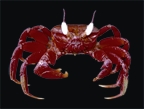 |
 |
 |
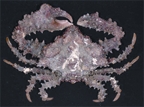 |
 |
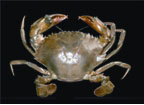 |
 |
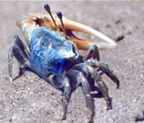 |
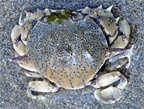 |
Most of these species are economically important but the serrated mud crab, also known as mangrove crab, or Scylla serrata is now the most commercially important species and is widely distributed in the Indo-Pacific region, including the bay of bengal. Bangladesh earns about US $ 6 million per year by exporting 1,500 m tons of live mud crab to Singapore, Hong Kong, China, Taiwan and Japan.

The segmentally organised body of crab is divided into a well-developed cephalothorax, and a highly reduced abdomen with six cephalic, eight thoracic and six abdominal segments. Each segment except the first bears a pair of uniramous or biramous appendages.
There are five pairs of legs used for running, swimming, jumping, climbing and burrowing. Crabs construct burrows of different shape and size mainly for concealment but mud crabs use those also at the time of molting and breeding. Crabs can breed throughout the year, but for mud crab peak seasons in Bangladesh are May to August, and December to February.
The commercially important species Scylla serrata usually spawns in the sea and its larvae are carried to the coast by tide. They attain sexual maturity six months after hatching and maturation of gonads and sexual activity is controlled by the secretion of hormones. An adult usually weighs 300-600 g though the largest one may grow up to 1kg weight (15 cm across the carapace). The ovigerous or berried females carry the fertilized egg mass in its broad abdomen.
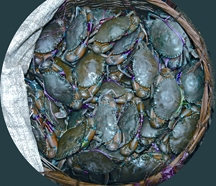
The hatched larva (Zoea 1) leads a planktonic life and after several moults turns into Zoea 5, and a single megalopa stage which metamorphoses into benthic juveniles that migrate to coasts and grow into adults in estuaries, rivers, mudflats and mangroves. Crabs form a dominant aqua-terrestrial fauna in the estuary and intertidal zones, particularly of the sundarbans mangrove ecosystem. They form the major food base for Bengal tigers, wild boars, jackals, monkeys, estuarine crocodiles, birds, and also for many fishes. On the other hand, crabs are scavengers, feeding on detritus feeders like polychaetes, crustaceans, molluscs, and dead fishes. They are opportunistic omnivores, cannibalistic, or carnivorous, but the graspid crab Varuna litterata is mainly herbivorous.
Crab fishery is now an important economic activity in Bangladesh. The major species for export is the mud crab (Scylla serrata). Crab fishers use dingi as their fishing boat and lines (single and multi-baited) and hooks as principal gears. They also use different types of nets and traps. The crabs harvested are transported live to collection centres or depots in wet gunny bags and bamboo baskets. Then after proper grading they are sent to Dhaka for final packing and finally exported to countries like Singapore, Hong Kong, Taiwan, China, and Japan. Individually tied crabs in covered baskets can be easily transported and can stay without water for 2-3 days.
Crab culture Implies growing or rearing of edible crabs to obtain a better crop or improve productivity. Worldwide crustacean aquaculture mainly represents culture of shrimp and lobsters. But in recent decades crab culture particularly the culture of mangrove mud crab, Scylla serrata, has received the most attention because of its market demand and decreasing natural production.
In Asian countries including Bangladesh commercial-scale crab culture appears to be mainly limited to the mud crab, though Japan has been producing seeds of blue crab Neptunus pelagicus in hatcheries for open water stocking as cannibalism is the major problem in growout ponds. Larval rearing and spawning of Portunus trituberculatus and king crab Paralithodes camtschatica has also been successful.
Seed production is the critical issue in crab culture. Sources of mud crab seeds are (i) the hatcheries, and (ii) nature. Although there are reports of hatcheries seed production in Taiwan, China, Malaysia, Japan, and India, most of the work done is experimental in nature. In Bangladesh, seed crabs are collected entirely from natural habitats. Usually, mud crabs matures at a carapace width of 10 cm at the age of about six months and spawning takes place within 10 days after eyestalk ablation. Hatching takes place after about 17 days of spawning at temperatures between 23° and 25°C. A 250g female may produce up to 1.5 million first zoea (Z1) larvae which take 2-3 days for each intermoult to reach the megalopa stage. The megalopa in 7-8 days metamorphoses to the first crab (juvenile) stage.
The hatching rate may be close to 100 percent, but mortality is heaviest during changes between zoea, megalopa and juveniles. Various feeds including the rotifer (Brachionus chlorella), the brine shrimp (Artemia) and copepods are used to feed the larvae. High salinity sea water (25-53 ppt) is best for larval rearing. Mud crab farmers still depend largely on natural wild seed. So, seed is a limiting factor for the expansion of crab culture in Bangladesh. Most farmers collect crab seeds from the tidal rivers and seacoast by using different nets. Crab fry may be available year round but the peak seasons are summer (May-August) and winter (December-February).
Culture techniques The mud crab is widely distributed in Indo-Pacific including the Bay of Bengal. The culture techniques of this crab include (i) rearing of young crabs in large farms, and (ii) fattening of postmoult 'water crabs' as well as immature crabs to marketable sizes.
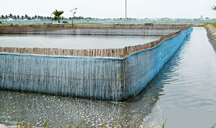
Crab seeds are usually stocked in large ponds, and are reared until they reach the marketable size and have well-developed gonads. They are reared as a part of polyculture system along with shrimp, milkfish, and seaweeds in Asian countries including Bangladesh where traditional shrimp farms, the ghers are the “growout” ponds. In such farms young crabs of 10-100 g are held up to 6-8 months until they reach the marketable size (usually 300-500g).
Fattening of crab is the monoculture of crab to produce 'egg crab' (female with ripe ovaries) and hard-shelled 'meat crab' (preferably a male with a hard body and large intact claws) in the ponds. Gravid female (egg crab) is the most valuable of all hard-shelled crabs in Asian markets and are sold for as much as US $ 14 per kg.
The fattening is essentially the rearing of recently moulted 'water crab', immature female crabs and crabs with broken legs to hard-shelled gonadal mature crabs. They are usually fed molluscs (preferably snails), trash fish and other special food to promote maturation. The culture is usually done in small earthen ponds fenced with bamboo screens and nylon nets to prevent them from escaping. The fattening cycle is short and generally last for 1-2 months. Stocking density is about 3 crabs (7-12 cm carapace width) per m2 water surface. Feeding rate is about 5 per cent of body weight daily, fed at dark. Fattening is also done in pens and cages. In Bangladesh crab fattening is now very popular in Pikegachha, Mongla, Satkhira, Kaliganj and the Munshiganj areas of greater Khulna. It is done in small ponds (60-600m2) with facilities of water change, cleaning and liming for water quality management. The optimum temperature and salinity ranges recommended are 12-25'C and 15-30 ppt respectively.
Traditionally, mud crab culture in Asia has been a small-scale activity to provide better management and integration in terms of the coastal environment. In Bangladesh, mostly shrimp ponds abandoned due to white spot virus diseases are now being used as fattening ponds. Traditional ghers used for shrimp farming as well as integrated paddy-cum shrimp culture are also used as crab growing farms with shrimp as the main crop.
The major problem in crab farming in Bangladesh is the scarcity of seed. The natural populations of mud crab are declining throughout Southeast Asia due to (i) over-exploitation, (ii) loss of natural mangrove habitat, and (iii) coastal environmental degradation. Obviously, much of the research efforts are now being diverted to commercial seed production in hatcheries and nurseries. With greater success in commercial seed production, development of appropriate culture technology, and proper investment, the mud crab farming may have a brighter prospect in Asia including Bangladesh. [Abu Tweb Abu Ahmed]
See also prawn, king crabs.
